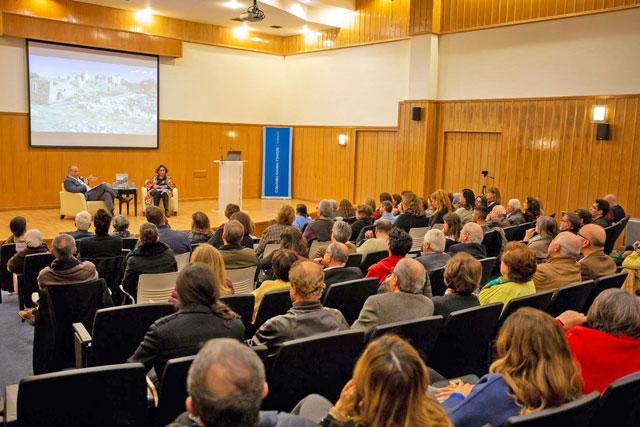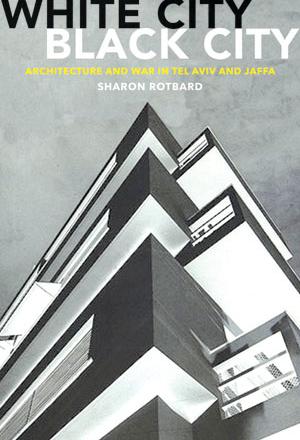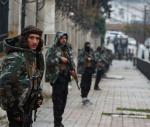You are here
Architect rehabilitates centuries-old Palestinian villages and towns
By Saeb Rawashdeh - Nov 27,2018 - Last updated at Nov 27,2018

Safwan Masri (left) and Suad Amiry talk about organic connectedness between the architecture of Palestinian villages and towns and the communities who inhabited them in the historical Palestine, at Columbia Global Centres in Amman, last week (Photo courtesy of Columbia Global Centres)
For Suad Amiry, the life-long goal has been to document, restore and protect 420 Palestinian villages in the West Bank, Jerusalem and Gaza.
In the 1970s the support for Palestine was much more internationalised than today, Amiry said at the talk titled “Peasant Architecture in Palestine”, at Columbia Global Centres in Amman last week.
Her most recent book ,“Peasant Architecture in Palestine: Space, Kinship and Gender”, evolved from a doctoral dissertation at the University of Edinburgh in 1987.
“As many of you know, we are tired of our PhD thesis, and the last thing we want to see is to work on our thesis again,” she explained,
Before arriving to Palestine in 1981, she modeled in her mind what Jaffa and other Palestinian sites look like, compared with Damascus where her father came from. Also, a trip to Italy with a group of friends was an eye opener.
“We went on a trip to Italy, and I saw all these little villages on Italian mountains and wondered how these people could protect their architecture that way? Maybe, I can do the research on the Palestinian architecture,” she remembered.
During an initial period in Palestine, she took as many photos of the local sites as possible, both of villages and small towns, to document heritage that is now gone due to extensive building of illegal housing units.
Although she studied modern architecture at the American University in Beirut, Amiry was always moved by old cities of Damascus, Cairo and Rome, and their historical background.
“What is it about these places that ‘talk back to me’?” she asked.
“When I walk in Birzeit, there is an organic relationship between me and the nature,” the architect explained.
Amiry discovered “the Mediterranean part” of herself when she went to Jaffa and saw “Beirut in it”.
According to the scholar, Hebron, a town in the hinterland, is a unique case, different from Nablus and Jerusalem, as Hebronites integrated three major methods of commerce: trade, farming and grazing, which is reflected in the architectural style of Hebron.
The Hebronite architecture was distinct, she noted, because it incorporates three modes of living, “as the influence of big urban centres like Damascus and Istanbul is less present than in Nablus”.
“Most of urban sites are located on the coast [Gaza, Jaffa and Haifa], while the heart of the peasant area is situated on mountains,” Amiry underlined, noting that Jerusalem’s economy was connected with pilgrims, while the only real city in the West Bank was Nablus.
After realising the effect of the Israeli occupation, she concluded that villages are the most vulnerable places to the Israeli forces demolition practices that completely changed the landscape.
“I support Palestine because it’s just a right cause, because it is the right position to take,” said Amiry, who is a conservation architect and founder of Riwak, an Aga Khan award-winning architectural conservation centre in the West Bank.
“It’s another colonisation, another occupation when a settler gets free land and a free house,”Amiry underlined, stressing that human issues are universal and do not know ethnic, racial and/or religious boundaries.
Related Articles
Having already published several excellent books on different aspects of Palestinian reality, Suad Amiry finally turns to her own field: architecture. The setting and subject matter of “Golda Slept Here” are the beautiful old Palestinian homes in the part of Jerusalem that was occupied in 1948, now dubbed West Jerusalem.
Palestinian history is reflected in so many facets of life, especially in its fashion; its embroidery recounts a narrative of rich heritage and culture passed from one generation to another. I decided to focus on this theme for my make-up pages this month. I chose three local fashion and textile designers Lina Lama Burgan, May Khoury and Dana Rimawi, as my muses.
First published in Hebrew 10 years ago, “White City — Black City” is part of a rare, but growing body of literature wherein Israelis take a hard, honest look at the consequences of how their state was founded and developed.

















